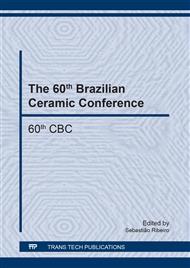p.170
p.175
p.180
p.185
p.191
p.196
p.202
p.207
p.212
Interlocking Concrete Paving Blocks Produced with Foundry Sand Waste
Abstract:
Industrialized products demand huge quantities of raw material, and generate enormous volumes of residue. This fact has caused an imbalance in the environment, such as the soil, the water tables, ecosystems and public health. The foundry industry, known for being one of the biggest users of raw material, is among the major pollutants. Concomitantly, the civil construction sector is notorious for its huge consumption of natural resources, but in contrast, it has the potential to aggregate residues from other industries, resulting in added- value products. Recycling is one of the alternatives found when trying to lessen the environmental impacts created by industrial waste, transforming residue into useful products for society. The goal of this research is to analyze the use of spent foundry sand (SFS) and foundry exhausted dust (ED) in the making of interlocking concrete paving blocks. These blocks have been made with foundry sand waste as aggregate and this element has been substituted partially by 0, 5, 10, 15 and 20% with exhausted dust. The blocks were technically analyzed for their compressive strength, measurement of dimension and water absorption. The results obtained concerning compressive strength were below the standard specification, whereas the dimensions and water absorption testing were in accordance with the Brazilian National Standards Organization NBR 9781 [1].
Info:
Periodical:
Pages:
191-195
Citation:
Online since:
January 2018
Price:
Сopyright:
© 2018 Trans Tech Publications Ltd. All Rights Reserved
Share:
Citation:


